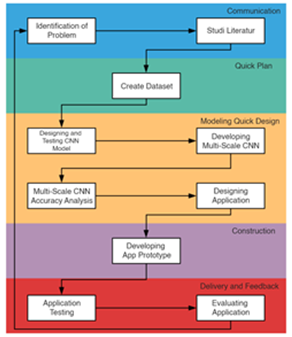Estimating Oil Palm Tree Yield and Soil Composition Using Multi-Scale CNN and Vegetation Indices
Keywords:
Convolutional Neural Network, yield estimation, vegetation index, remote sensingAbstract
Indonesia is one of the countries in the world with the largest oil palm plantations besides Malaysia which is administratively a neighbour. The process of monitoring oil palm plantation is an important part of supporting the sustainability of the industry in a fluctuating market. Currently, monitoring of oil palm plantations is still using conventional methods through surveys at the plantation location which take a long time. The aim of the study was to count the number and assess the health level of oil palm trees and soil composition to assist plantation managers in making decisions to provide maximum economic benefits. By implementing the Multi-Scale CNN model, oil palm trees can be detected faster and accurately, where the combination of land cover and object classification architecture of ResNet-18 can produce accuracy with an average F1-score of 90.25%. Then by developing a prototype that integrates the Multi-Scale CNN model and the vegetation index, the yields and soil composition can be estimated, thus assisting the user in making a quick decision.
Downloads
References
M. Euler, V. Krishna, S. Schwarze, H. Siregar, and M. Qaim, “Oil Palm Adoption, Household Welfare, and Nutrition Among Smallholder Farmers in Indonesia,” World Dev, vol. 93, pp. 219–235, May 2017, doi: 10.1016/j.worlddev.2016.12.019.
G. M. Foody et al., “Mapping the biomass of Bornean tropical rain forest from remotely sensed data,” Global Ecology and Biogeography, vol. 10, no. 4, pp. 379–387, 2001, doi: 10.1046/j.1466-822X.2001.00248. x.
H. Z. M. Shafri, N. Hamdan, and M. I. Saripan, “Semi-automatic detection and counting of oil palm trees from high spatial resolution airborne imagery,” Int J Remote Sens, vol. 32, no. 8, pp. 2095–2115, 2011, doi: 10.1080/01431161003662928.
Y. Basiron, “Palm oil production through sustainable plantations,” European Journal of Lipid Science and Technology, vol. 109, no. 4, pp. 289–295, 2007, doi: 10.1002/ejlt.200600223.
Corley; R.H.V. and Tinker; P.B., “The Oil Palm: Fifth Edition,” Blackwell Science, vol. 5th, pp. 1–680, 2015, doi: 10.1002/9781118953297.
K. L. Chong, K. D. Kanniah, C. Pohl, and K. P. Tan, “A review of remote sensing applications for oil palm studies,” Geo-Spatial Information Science, vol. 20, no. 2, pp. 184–200, Apr. 2017, doi: 10.1080/10095020.2017.1337317.
United Nations Environment Programme, “Oil Palm Plantations: Threats and Opportunities for Tropical Ecosystems,” UNEP Global Environmental Alert Service (GEAS), 2011. https://wedocs.unep.org/20.500.11822/32263 (accessed Dec. 28, 2022).
S. B. Hansen, R. Padfield, K. Syayuti, S. Evers, Z. Zakariah, and S. Mastura, “Trends in global palm oil sustainability research,” J Clean Prod, vol. 100, pp. 140–149, Aug. 2015, doi: 10.1016/j.jclepro.2015.03.051.
W. Li, R. Dong, H. Fu, and L. Yu, “Large-scale oil palm tree detection from high-resolution satellite images using two-stage convolutional neural networks,” Remote Sens (Basel), vol. 11, no. 1, Jan. 2019, doi: 10.3390/rs11010011.
W. Li, H. Fu, L. Yu, and A. Cracknell, “Deep learning-based oil palm tree detection and counting for high-resolution remote sensing images,” Remote Sens (Basel), vol. 9, no. 1, 2017, doi: 10.3390/rs9010022.
Government of Canada, “Spatial Resolution, Pixel Size, and Scale,” Natural Resources Canada, 2015. https://www.nrcan.gc.ca/maps-tools-and-publications/satellite-imagery-and-air-photos/tutorial-fundamentals-remote-sensing/satellites-and-sensor
K. He, X. Zhang, S. Ren, and J. Sun, “Deep Residual Learning for Image Recognition,” in Proceedings of the IEEE Conference on Computer Vision and Pattern Recognition (CVPR), 2016, pp. 770–778. [Online]. Available: http://image-net.org/challenges/LSVRC/2015/
A. Zhang, Z. C. Lipton, M. Li, and A. J. Smola, Dive into Deep Learning, vol. v3. 2022. doi: 10.48550/ARXIV.2106.11342.
J. Han, M. Kamber, and J. Pei, Data mining: concepts and techniques, vol. 4th. 2022.
S. K. Balasundram, H. Memarian, R. Khosla, and R. Khosla, “Estimating Oil Palm Yields using Vegetation Indices Derived from Quickbird,” Life Sci J, vol. 10, no. 4, pp. 1097–8135, 2013, doi: 10.4: 851-860.
F. Marzukhi, A. L. Elahami, and S. N. Bohari, “Detecting nutrients deficiencies of oil palm trees using remotely sensed data,” in IOP Conference Series: Earth and Environmental Science, Jul. 2016, vol. 37, no. 1, pp. 1–11. doi: 10.1088/1755-1315/37/1/012040.
K. J. Goh, “Fertilizer recommendation systems for oil palm: estimating the fertilizer rates,” in Proceedings of MOSTA Best practices workshops-agronomy and crop management. Malaysian Oil Scientists’ and Technologists’ Association, 2005, pp. 1–37.

Downloads
Published
How to Cite
Issue
Section
License
Copyright (c) 2023 Edy Irwansyah , Alexander Agung Santoso Gunawan, Izzi Dzikri

This work is licensed under a Creative Commons Attribution-ShareAlike 4.0 International License.
All papers should be submitted electronically. All submitted manuscripts must be original work that is not under submission at another journal or under consideration for publication in another form, such as a monograph or chapter of a book. Authors of submitted papers are obligated not to submit their paper for publication elsewhere until an editorial decision is rendered on their submission. Further, authors of accepted papers are prohibited from publishing the results in other publications that appear before the paper is published in the Journal unless they receive approval for doing so from the Editor-In-Chief.
IJISAE open access articles are licensed under a Creative Commons Attribution-ShareAlike 4.0 International License. This license lets the audience to give appropriate credit, provide a link to the license, and indicate if changes were made and if they remix, transform, or build upon the material, they must distribute contributions under the same license as the original.





